An Enhanced MOPSO Algorithm for Energy-Efficient Single-Machine Production Scheduling
Abstract
1. Introduction
2. The Scheduling Problem
2.1. Problem Statement
- All jobs are available at time zero.
- The machine can handle only one job at a time.
- There are no precedence relations between the jobs.
- Preemption is not allowed.
- Setup times are not considered.
2.2. A Small Example
3. The Proposed Algorithm
3.1. The Basic PSO Algorithm
3.2. Encoding and Decoding
3.3. Solution Initialization
3.4. Sorting of Solutions
- and
- and
3.5. External Repository and Updating Mechanisms
3.6. The Mutation Operator
3.7. Local Search
3.8. MOPSO-LS Framework
4. Computational Experiments
4.1. Experimental Settings
- The basic processing time of each job is generated uniformly from .
- The deterioration factor of each job is generated from the uniform distribution .
- The latest starting time of each job where n is the number of jobs.
4.2. The Performance Measures
4.3. Parameter Tuning Experiments
4.4. Performance Comparison
- MOPSO-LS shows excellent performance for almost all instances in terms of GD, which suggests that the solutions obtained by MOPSO-LS are closer to the approximate Pareto front. Since all the computational tests are conducted in limited time, we can judge from the table that the convergence speed of MOPSO-LS is much faster than that of MOPSO and NSGA-II, especially for large-scale instances.
- For some instances, the NSGA-II achieved better results in terms of SP, meaning that the solutions of NSGA-II are distributed more evenly. However, it should be noted that the NSGA-II solutions were located far from the approximate Pareto front, and in this case, the number of non-dominated solutions tends to be much larger and thus it is easier to find evenly spread solutions. Therefore, even though NSGA-II sometimes obtains a better SP, the inferior GD performance indicates worse solution quality.
- From the table, we can see that the k-opt operator has improved the performance of MOPSO significantly. It is found that three-opt and four-opt are often more powerful than two-opt. However, there is no definite conclusion regarding which one of three-opt and four-opt is more effective (the result appears to be instance-dependent).
5. Conclusions
Author Contributions
Funding
Acknowledgments
Conflicts of Interest
References
- Wang, S.; Liu, M.; Chu, F.; Chu, C. Bi-objective optimization of a single machine batch scheduling problem with energy cost consideration. J. Clean. Prod. 2016, 137, 1205–1215. [Google Scholar] [CrossRef]
- Wang, H.; Alidaee, B. Effective heuristic for large-scale unrelated parallel machines scheduling problems. Omega 2019, 83, 261–274. [Google Scholar] [CrossRef]
- Plitsos, S.; Repoussis, P.P.; Mourtos, I.; Tarantilis, C.D. Energy-aware decision support for production scheduling. Decis. Support Syst. 2017, 93, 88–97. [Google Scholar] [CrossRef]
- Aghelinejad, M.; Ouazene, Y.; Yalaoui, A. Complexity analysis of energy-efficient single machine scheduling problems. Oper. Res. Perspect. 2019, 6, 100105. [Google Scholar] [CrossRef]
- Zhang, R.; Chiong, R. Solving the energy-efficient job shop scheduling problem: A multi-objective genetic algorithm with enhanced local search for minimizing the total weighted tardiness and total energy consumption. J. Clean. Prod. 2016, 112, 3361–3375. [Google Scholar] [CrossRef]
- Wu, X.; Shen, X.; Li, C. The Flexible Job-Shop Scheduling Problem Considering Deterioration Effect and Energy Consumption Simultaneously. Comput. Ind. Eng. 2019, 135, 1004–1024. [Google Scholar] [CrossRef]
- Liao, X.; Zhang, R.; Chiong, R. Multi-objective optimization of single machine scheduling with energy consumption constraints. In Proceedings of the 2017 IEEE Symposium Series on Computational Intelligence (SSCI), Honolulu, HI, USA, 27 November–1 December 2017; pp. 1–8. [Google Scholar]
- Módos, I.; Šŭcha, P.; Hanzálek, Z. Algorithms for robust production scheduling with energy consumption limits. Comput. Ind. Eng. 2017, 112, 391–408. [Google Scholar] [CrossRef]
- Khorshidian, H.; Javadian, N.; Zandieh, M.; Rezaeian, J.; Rahmani, K. A genetic algorithm for JIT single machine scheduling with preemption and machine idle time. Expert Syst. Appl. 2011, 38, 7911–7918. [Google Scholar] [CrossRef]
- Behnamian, J. A parallel competitive colonial algorithm for JIT flowshop scheduling. J. Comput. Sci. 2014, 5, 777–783. [Google Scholar] [CrossRef]
- Wang, J.B.; Xia, Z.Q. Flow shop scheduling with deteriorating jobs under dominating machines. Omega 2006, 34, 327–336. [Google Scholar] [CrossRef]
- Wang, J.B.; Ng, C.; Cheng, T.E. Single-machine scheduling with deteriorating jobs under a series–parallel graph constraint. Comput. Oper. Res. 2008, 35, 2684–2693. [Google Scholar] [CrossRef]
- Wang, J.B.; Liu, L.L. Two-machine flow shop problem with effects of deterioration and learning. Comput. Ind. Eng. 2009, 57, 1114–1121. [Google Scholar] [CrossRef]
- Lenstra, J.K.; Kan, A.R.; Brucker, P. Complexity of machine scheduling problems. Ann. Discrete. Math. 1977, 1, 343–362. [Google Scholar]
- Coello Coello, C.A.; Pulido, G.T.; Lechuga, M.S. Handling multiple objectives with particle swarm optimization. IEEE Trans. Evol. Comput. 2004, 8, 256–279. [Google Scholar] [CrossRef]
- Van Veldhuizen, D.A.; Lamont, G.B. Evolutionary Computation and Convergence to a Pareto Front. 1998. Available online: https://pdfs.semanticscholar.org/f329/eb18a4549daa83fae28043d19b83fe8356fa.pdf (accessed on 1 August 2019).
- Schott, J.R. Fault Tolerant Design Using Single and Multicriteria Genetic Algorithm Optimization; Technical Report; Air Force Inst of Tech Wright-Patterson AFB OH: Dayton, OH, USA, 1995. [Google Scholar]
- Taguchi, G.; Phadke, M.S. Quality engineering through design optimization. In Quality Control, Robust Design, and the Taguchi Method; Springer: Boston, MA, USA, 1989; pp. 77–96. [Google Scholar]
- Deb, K.; Pratap, A.; Agarwal, S.; Meyarivan, T. A fast and elitist multiobjective genetic algorithm: NSGA-II. IEEE Trans. Evol. Comput. 2002, 6, 182–197. [Google Scholar] [CrossRef]
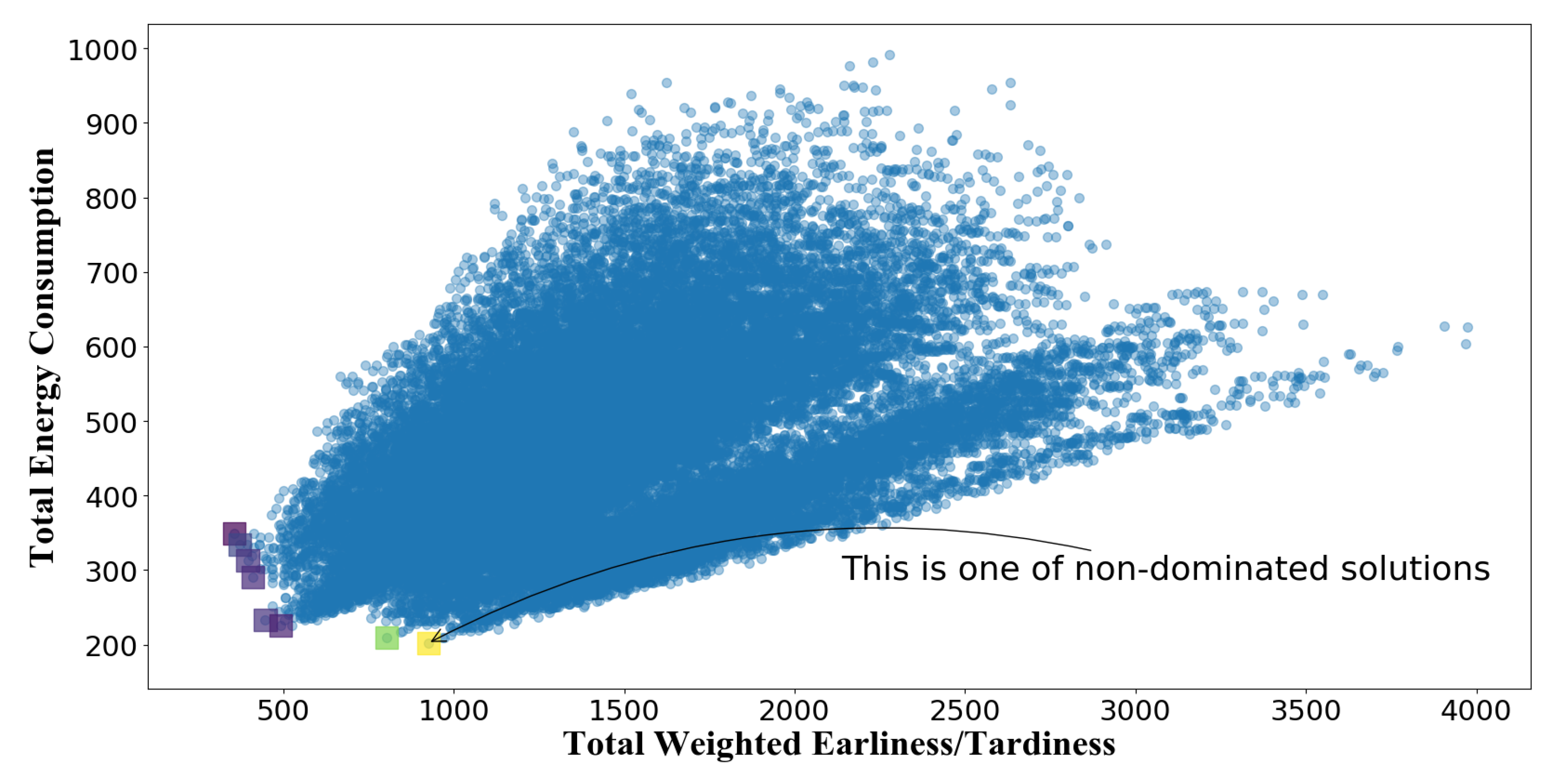
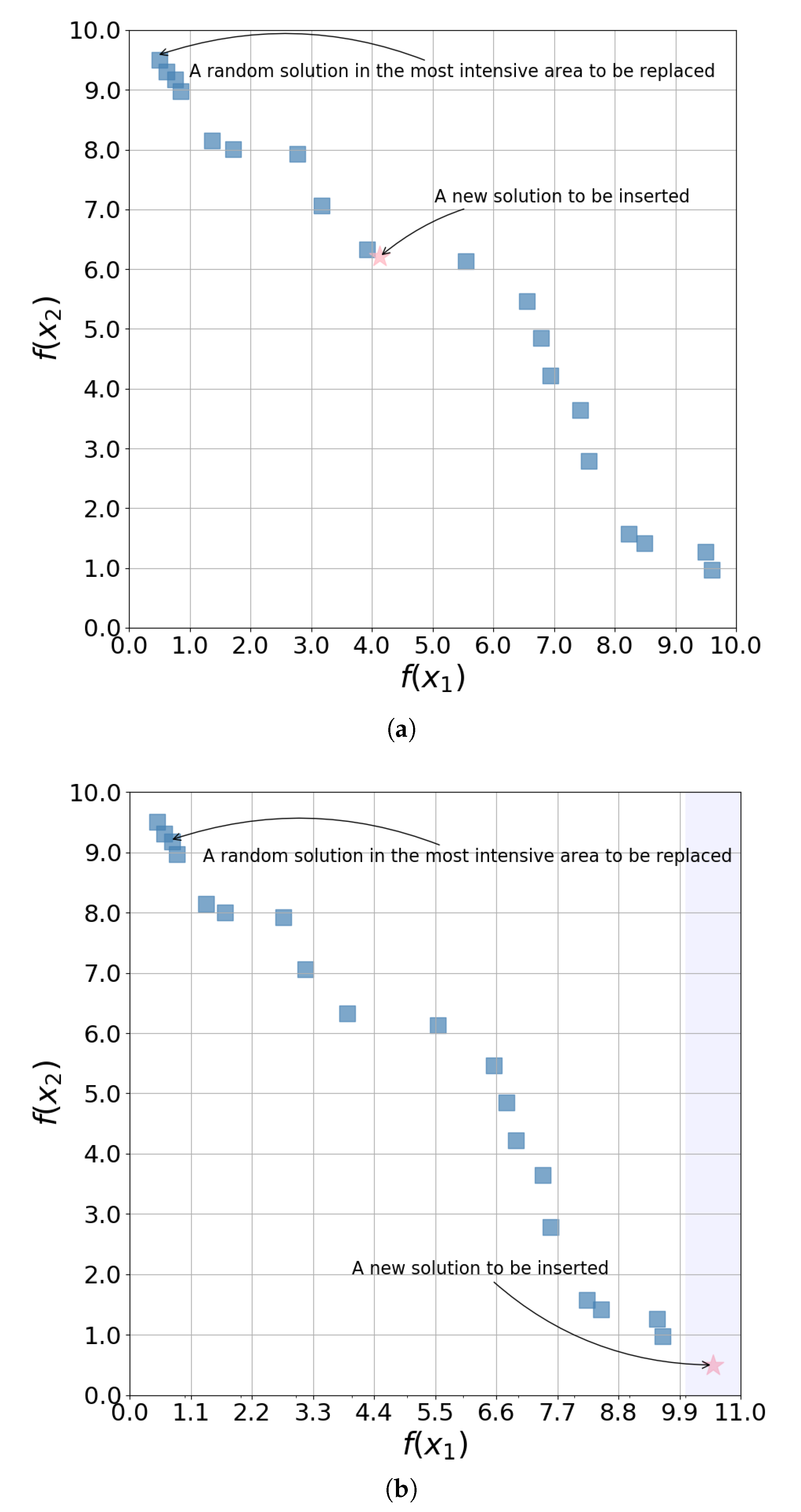
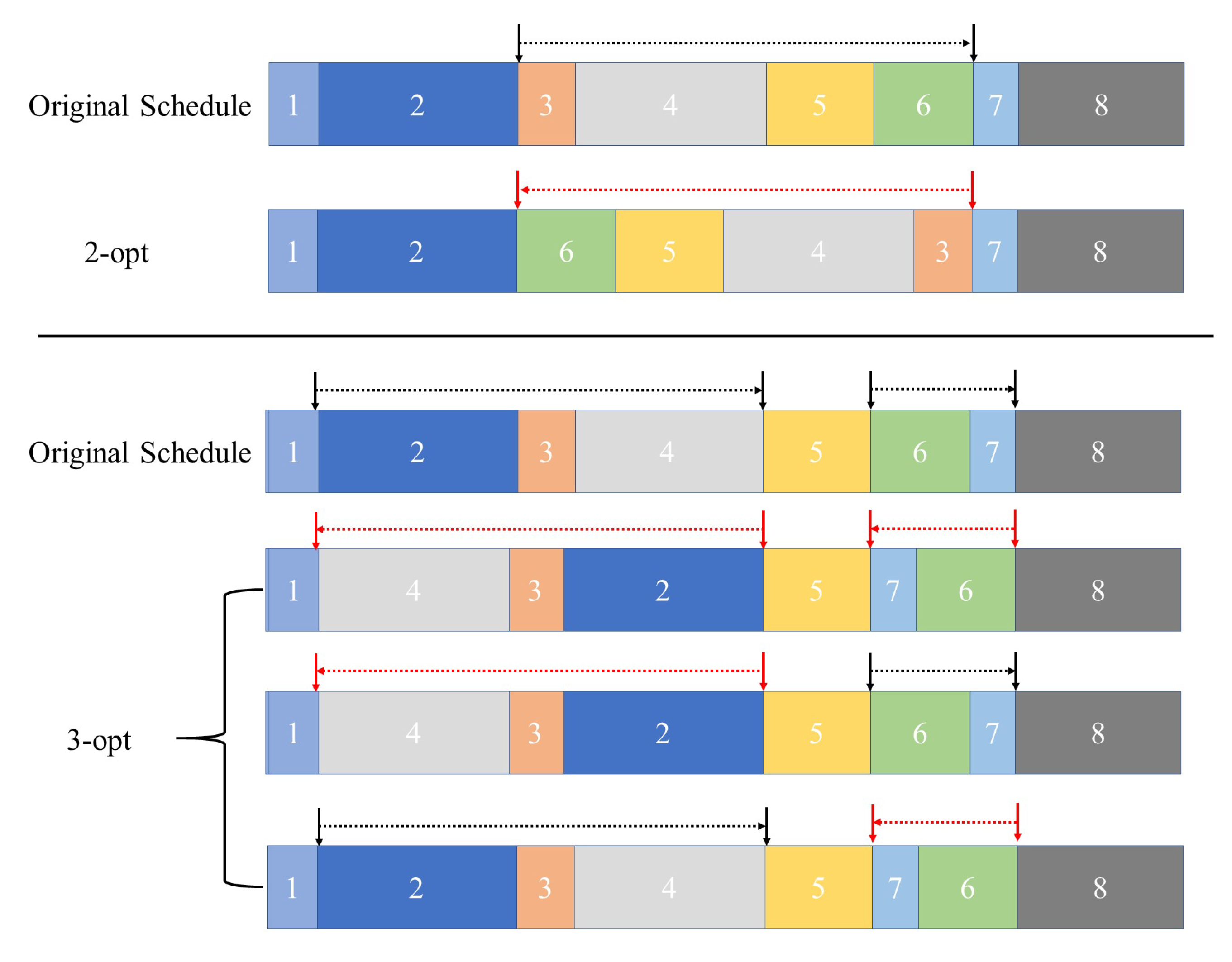

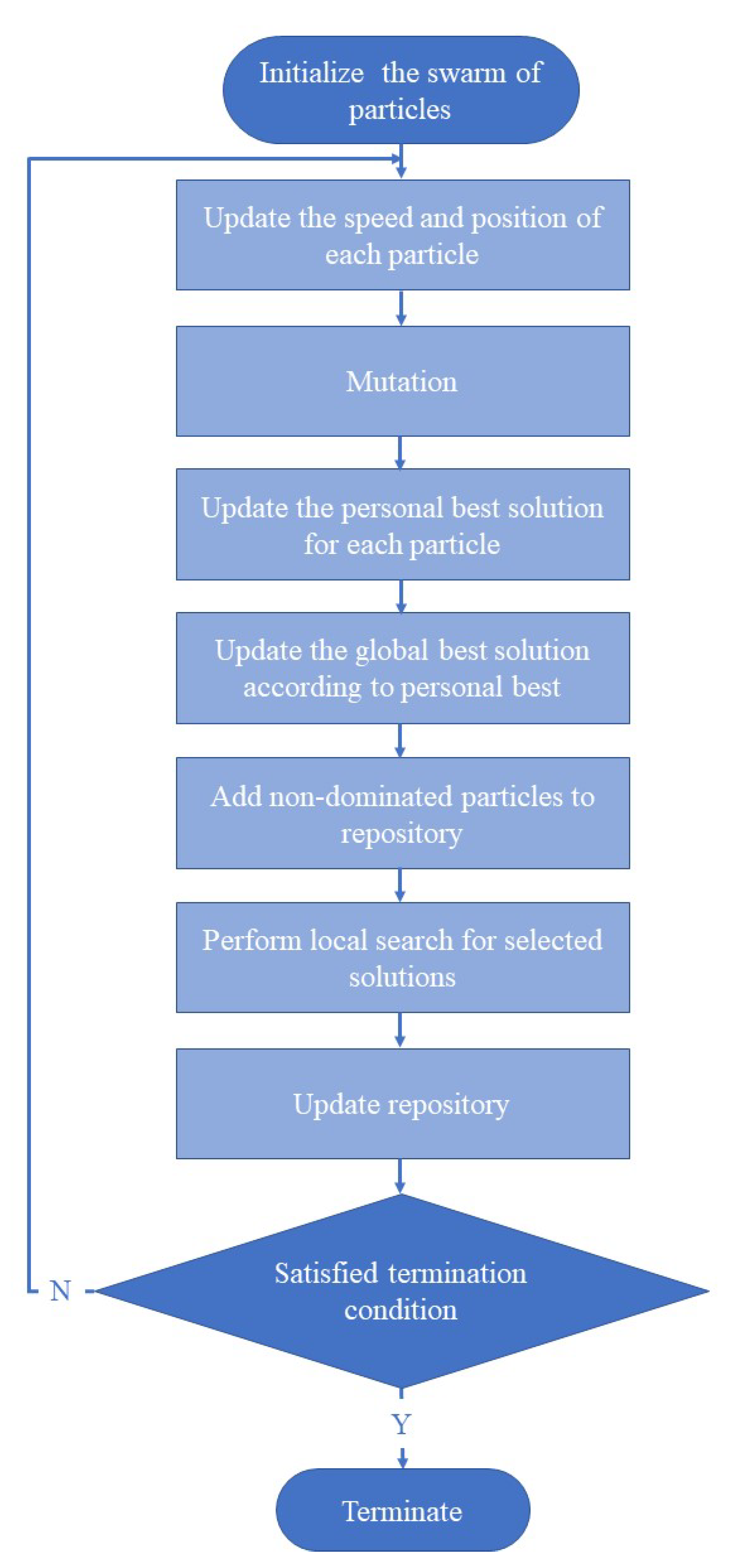
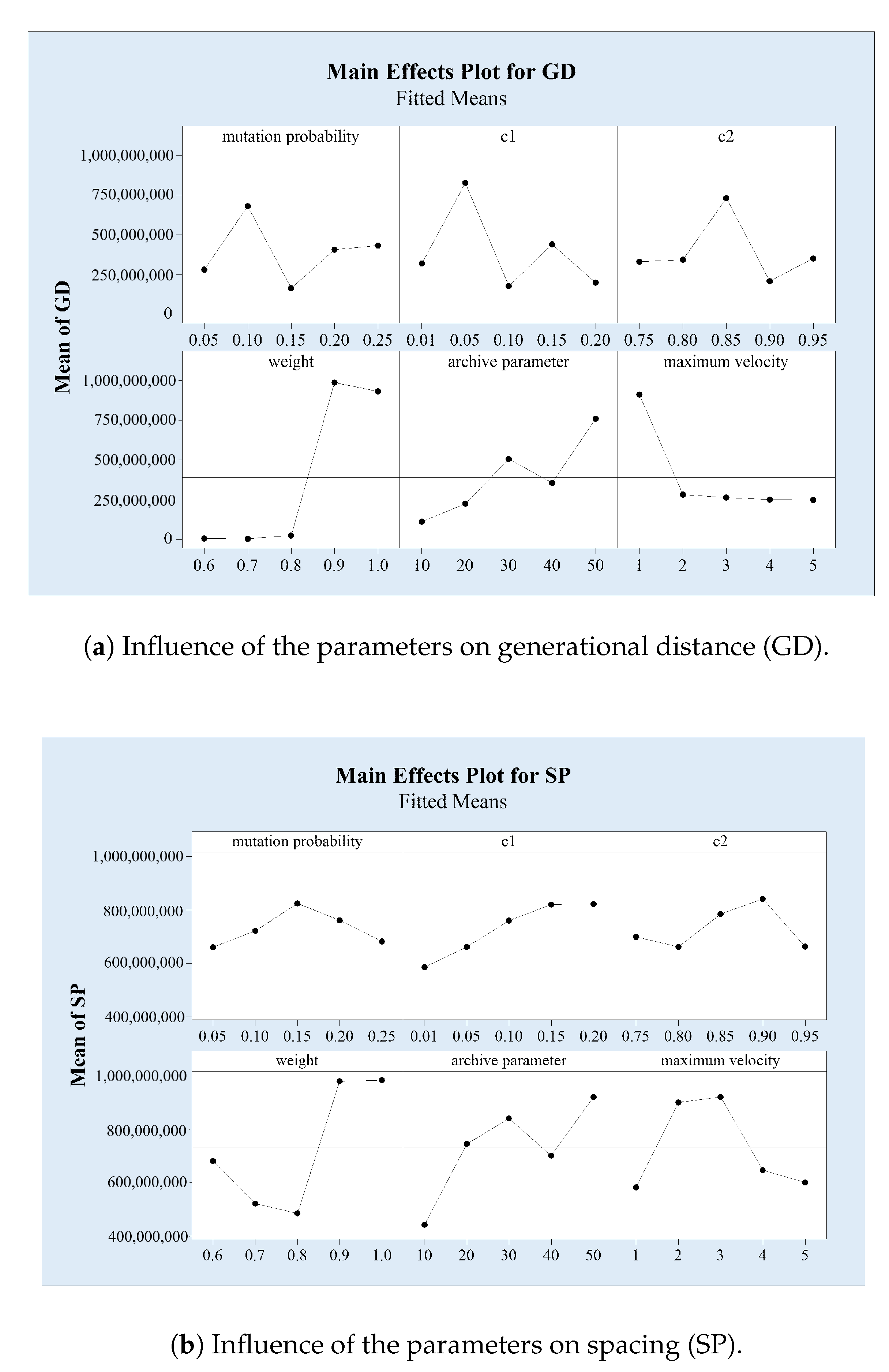
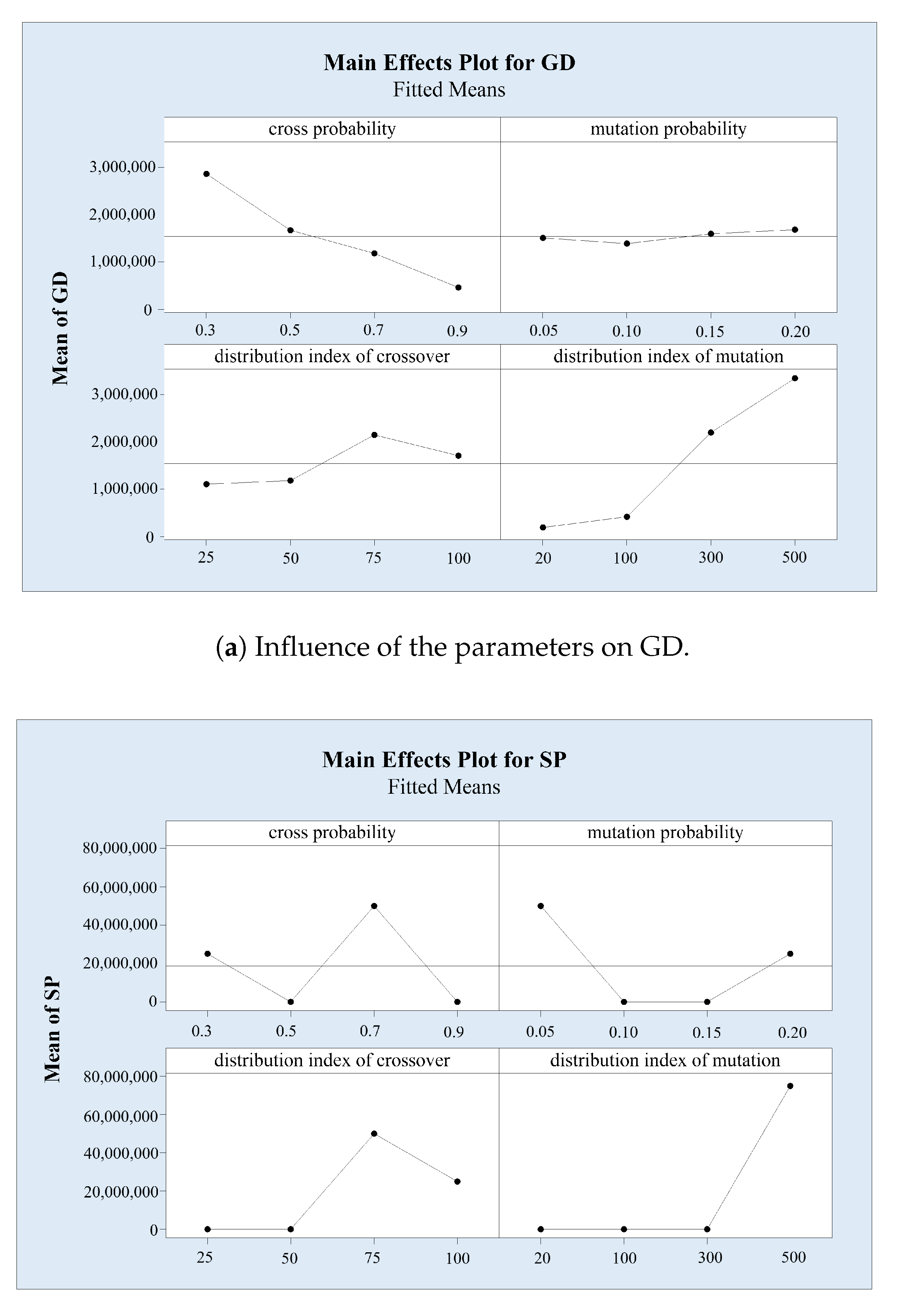

| j | ||||||
|---|---|---|---|---|---|---|
| 1 | 5 | 12 | 3 | 0.9818 | 5 | 3 |
| 2 | 3 | 16 | 2 | 0.4282 | 30 | 2 |
| 3 | 10 | 11 | 3 | 0.3046 | 29 | 5 |
| 4 | 4 | 6 | 1 | 0.3868 | 12 | 9 |
| 5 | 6 | 5 | 5 | 0.2814 | 19 | 6 |
| 6 | 6 | 8 | 5 | 0.6004 | 15 | 5 |
| 7 | 6 | 21 | 3 | 0.8456 | 25 | 1 |
| 8 | 7 | 21 | 2 | 0.8839 | 34 | 6 |
| Item | Distribution |
|---|---|
| n |
| Parameter | Values | ||||
|---|---|---|---|---|---|
| 0.6 | 0.7 | 0.8 | 0.9 | 1 | |
| 0.01 | 0.05 | 0.1 | 0.15 | 0.2 | |
| 0.75 | 0.8 | 0.85 | 0.9 | 0.95 | |
| 0.05 | 0.1 | 0.15 | 0.2 | 0.25 | |
| 1 | 2 | 3 | 4 | 5 | |
| 10 | 20 | 30 | 40 | 50 | |
| Parameter | Values | |||
|---|---|---|---|---|
| 0.3 | 0.5 | 0.7 | 0.9 | |
| 0.05 | 0.1 | 0.15 | 0.2 | |
| 25 | 50 | 75 | 100 | |
| 20 | 100 | 300 | 500 | |
| Size | MOPSO-LS | MOPSO | NSGA-II | ||
|---|---|---|---|---|---|
| 2-opt | 3-opt | 4-opt | |||
| 15 | 145.84 | 147.43 | 154.49 | 152.77 | 169.78 |
| 21.53 | 59.32 | 77.89 | 111.21 | 60.28 | |
| 545.36 | 696.60 | 625.72 | 654.69 | 511.43 | |
| 73.52 | 21.66 | 21.66 | 14.04 | 52.05 | |
| 36.27 | 20.17 | 41.10 | 55.28 | 126.85 | |
| 99.61 | 87.36 | 73.25 | 90.70 | 105.44 | |
| 122.1 | 72.22 | 68.31 | 80.01 | 84.22 | |
| 37.66 | 12.31 | 13.20 | 11.20 | 36.02 | |
| 87.21 | 25.81 | 11.92 | 24.52 | 158.49 | |
| 604.48 | 463.84 | 569.45 | 374.33 | 458.47 | |
| 30 | |||||
| 8193.22 | 4345.53 | 4005.72 | 4149.82 | 5625.59 | |
| 9405.30 | 6565.11 | ||||
| 2379.98 | 1827.37 | 2465.72 | 2471.71 | 2638.53 | |
| 1769.88 | 780.76 | 510.60 | 972.319 | 1395.41 | |
| 1315.26 | 1047.49 | 1730.21 | 788.371 | 2700.17 | |
| 449.75 | 129.74 | 145.05 | 104.15 | 129.403 | |
| 1452.09 | 701.53 | 916.55 | 1460.24 | 2258.18 | |
| 2815.46 | 2088.30 | 2770.65 | 3052.56 | 2385.77 | |
| 4152.91 | 6286.43 | 5394.63 | 4709.27 | 5571.63 | |
| 50 | |||||
| 75 | |||||
| 100 | |||||
| Size | MOPSO-LS | MOPSO | NSGA-II | ||
|---|---|---|---|---|---|
| 2-opt | 3-opt | 4-opt | |||
| 15 | 509.19 | 578.29 | 584.30 | 638.47 | 923.56 |
| 417.51 | 435.21 | 555.21 | 477.75 | 444.19 | |
| 307.09 | 267.71 | 366.51 | 283.58 | 318.55 | |
| 523.81 | 363.69 | 363.69 | 369.30 | 355.70 | |
| 1011.11 | 1125.7 | 1081.63 | 1147.83 | 1119.74 | |
| 306.20 | 188.57 | 300.31 | 232.26 | 209.33 | |
| 357.33 | 373.69 | 342.90 | 414.66 | 245.61 | |
| 315.46 | 207.31 | 246.36 | 222.78 | 164.90 | |
| 514.11 | 481.24 | 447.95 | 453.79 | 492.89 | |
| 517.20 | 367.61 | 413.56 | 686.38 | 452.984 | |
| 30 | 2100.79 | 1814.01 | 1698.64 | 1655.26 | 1165.11 |
| 6485.56 | 5272.55 | 4262.61 | 4490.44 | 6924.92 | |
| 2165.40 | 1275.67 | 1412.01 | 1486.20 | 778.504 | |
| 2766.03 | 1390.19 | 1524.81 | 1583.83 | 1093.13 | |
| 1284.55 | 752.24 | 738.56 | 859.83 | 557.49 | |
| 1677.26 | 1111.53 | 1202.81 | 1068.90 | 992.56 | |
| 1937.24 | 875.54 | 913.88 | 944.60 | 709.31 | |
| 5533.60 | 2317.05 | 2425.59 | 2530.01 | 2158.28 | |
| 1819.30 | 934.22 | 1027.82 | 944.33 | 596.92 | |
| 4243.48 | 2499.02 | 2055.34 | 1927.15 | 1582.82 | |
| 50 | |||||
| 75 | |||||
| 100 | |||||
© 2019 by the authors. Licensee MDPI, Basel, Switzerland. This article is an open access article distributed under the terms and conditions of the Creative Commons Attribution (CC BY) license (http://creativecommons.org/licenses/by/4.0/).
Share and Cite
Liu, Y.; Liao, X.; Zhang, R. An Enhanced MOPSO Algorithm for Energy-Efficient Single-Machine Production Scheduling. Sustainability 2019, 11, 5381. https://doi.org/10.3390/su11195381
Liu Y, Liao X, Zhang R. An Enhanced MOPSO Algorithm for Energy-Efficient Single-Machine Production Scheduling. Sustainability. 2019; 11(19):5381. https://doi.org/10.3390/su11195381
Chicago/Turabian StyleLiu, Yueyue, Xiaoya Liao, and Rui Zhang. 2019. "An Enhanced MOPSO Algorithm for Energy-Efficient Single-Machine Production Scheduling" Sustainability 11, no. 19: 5381. https://doi.org/10.3390/su11195381
APA StyleLiu, Y., Liao, X., & Zhang, R. (2019). An Enhanced MOPSO Algorithm for Energy-Efficient Single-Machine Production Scheduling. Sustainability, 11(19), 5381. https://doi.org/10.3390/su11195381




